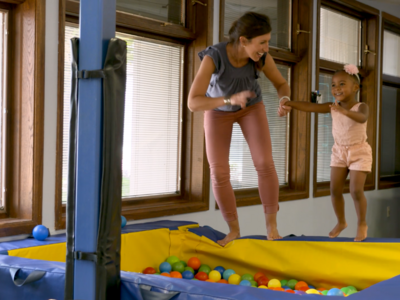Sensory Integration Therapy Enhances Nervous System Development

Empowering Self-Actualization
In the world of therapy, sensory integration therapy stands out as a powerful approach that harnesses the potential of play to facilitate the maturation of the nervous system. By providing playful, repeated, and successful sensory motor experiences, sensory integration therapy (as conceptualized by Ayres) offers children the chance to make sense of day-to-day experiences that were once challenging.
Unleashing the Potential of Play
Sensory integration therapy recognizes the significance of play in a child's development. Through carefully designed and structured activities, Sensory integration therapy creates opportunities for children to engage in playful, sensory-rich experiences. These experiences are not only enjoyable but also serve a purpose: to facilitate the maturation of the nervous system.
We start by identifying the unique detailed sensory profile and processing style of the client. The focus is on fostering a sense of empowerment and self-actualization. Sensory integration therapy creates a safe and inclusive environment, where therapists work collaboratively with individuals, valuing their autonomy and comfort.
Maturation through Repetition and Success
By providing repeated successful sensory motor experiences, sensory integration therapy allows children to navigate and comprehend day-to-day experiences that were once overwhelming or perplexing. By providing playful, repeated, and successful sensory motor experiences, Sensory Integration Therapy facilitates neural optimization, synaptic growth, pruning, and streamlining of pathways. Additionally, these repeated experiences support myelination, the process of forming a protective sheath around nerve fibers, through sensory-rich stimulation. This myelin sheath enhances the speed and efficiency of neural communication, enabling smoother transmission of sensory information. As a result, the nervous system becomes better equipped to regulate sensation at the synaptic level, contributing to improved sensory modulation.
Posture, Praxis, and Overall Well-Being
One of the remarkable outcomes of sensory integration is the maturation and improvement of posture and praxis capacity. As individuals engage in purposeful sensory motor activities, their ability to plan and execute movements (praxis) becomes more efficient and refined. This growth in praxis capacity not only enhances motor skills but also supports overall well-being. Improved posture and praxis contribute to increased confidence, independence, and participation in daily activities, ultimately improving the individual's quality of life. As a result, they can navigate their environment more effectively, engage in daily activities with greater ease, and develop stronger functional abilities.
When sensory integration therapy (SIT) is implemented correctly, it is important to highlight that it is empowering and fully aligned with neurodiversity affirming practice. A well-executed sensory integration approach respects and acknowledges the individual's unique sensory profile. It embraces the idea that there is a wide range of sensory experiences and preferences among individuals, and aims to support each person's specific needs for optimal nervous system development. By providing a safe and inclusive environment, sensory integration therapy fosters a collaborative and empowering therapeutic relationship, where the individual's autonomy and success are prioritized.
Corrective Recapitulation
Corrective recapitulation is a concept in psychology that involves revisiting and re-experiencing past traumas or unresolved issues in order to heal and integrate them into one's current self. Sensory integration play-based sessions that provide the "just right challenge" can indeed be a form of corrective recapitulation. In these sessions, individuals are given opportunities to engage in activities that challenge their sensory processing abilities in a safe and supportive environment. By engaging in these activities, individuals may have the opportunity to revisit and re-experience past sensory experiences in a controlled and therapeutic setting. This can allow them to process and integrate these experiences in a new way, leading to healing and growth.
Playing in the sensory gym not only remediates past experiences but also liberates and supports individuals by activating maturation processes. Success, play, trust, and safety are key elements that help facilitate this activation. The brain's development and maturation can be influenced by the experiences it encounters, and sometimes, due to the way childhood is structured or the world around us, the brain may have missed out on the right experiences.
Activation of Maturation Processes
Within the sensory gym, individuals engage in play that promotes success, fosters trust, and provides a safe environment. By offering opportunities for exploration and interaction with sensory stimuli, the sensory gym allows individuals to have positive and successful experiences that were previously lacking. This process activates neural pathways, stimulates synaptic growth, and supports the brain's maturation.
Through play, individuals can develop a sense of mastery, build confidence, and expand their comfort zones. The supportive and structured environment of the sensory gym combined with the therapeutic relationship helps create a foundation of trust. Theses safe spaces can then become brave spaces where individuals can take risks, push themselves, and tune into their bodies. By providing the right experiences in a safe and nurturing setting, the sensory gym aids in the activation of maturation processes that may have been previously hindered.
This relates to the biopsychosocial-environmental model of disability. The responsibility for the lack of appropriate experiences lies with the world and the way childhood is structured, rather than the child themselves. The sensory gym serves as a transformative space that addresses this gap, allowing individuals to access the experiences necessary for nervous system maturation. By embracing the principles of success, play, trust, and safety, the sensory gym helps liberate and support individuals in their journey towards optimal development and well-being.
